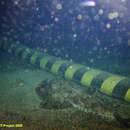Diagnostic Description
(
Inglês
)
fornecido por FAO species catalogs
Body and head strongly depressed. Gill openings extending below and behind pectoral fin base. Dorsal finrays VI + 11-12; esca (fleshy appendage at end of first dorsal spine) bifid, composed of 2 broad, flattened, leaf-like blades; dorsal spines II-VI long, stout and bearing numerous well-developed tendrils; length of fouth dorsal spine greater than snout width. Anal finrays 9-10. Peritoneum pale. Colour in preservative highly variable, uniform or mottled light to very dark brown above, white below; dorsal surface of pectoral fin as body proximally, darker distally; ventral surface of pectoral fin white with dark brown band on distal quarter; pelvic fins white with dusky interradial membranes; all fin rays with pale tips; esca as described above, black spot at base; illicium pigmented as dorsal body surface.
- Buen, F. de. - 1926Catálogo ictiológico del Mediterráneo Español y de Marruecos, recopilando lo publicado sobre peces de las costas mediterráneas y próximas del Atlántico (Mar de España). Resultados Camp. Int. Inst. esp. Oceanogr., 2: 1-221.
- Caruso, J. H. - 1983The systematics and distribution of the Liphiid anglerfishes: II. Revisions of the genera Lophiomus and Lophius. Copeia, 1983 (1): 11-30.
- Caruso, J. H. - 1986 Lophiidae. In: P.J.P. Whitehead et al., (eds.).Fishes of the North-eastern Atlantic and the Mediterranean (FNAM). Unesco, Paris, vol. III: 1362-1363. Fishbase: ICLARM .
- Lloris, D, J. Rucabado, LL del cerro, F. Portas, M. Demestre & A. Roig. - 1984Tots els peixos del mar Català. I: Llistat de Cites i de referències. Treballs Soc. Cat. Ict. Herp., 1: 1-208. S
Distribution
(
Inglês
)
fornecido por FAO species catalogs
Mediterranean, Black Sea, eastern North Atlantic from Straits of Gibraltar to south-western Barents Sea.
Size
(
Inglês
)
fornecido por FAO species catalogs
Attains a maximum length of 200 cm; common 20-100 cm.
Brief Summary
(
Inglês
)
fornecido por FAO species catalogs
Benthic,from shallow, inshore waters to 500 m.Feeds mainly on fishes, occasionally sea-birds. Spawning February-July.
Benefits
(
Inglês
)
fornecido por FAO species catalogs
Caught commercially with bottom trawls, gill nets, and bottom longlines. The total catch reported for this species to FAO for 1999 was 53 322 t. The countries with the largest catches were UK (16 989 t) and France (10 592 t). Marketed fresh and frozen; eaten steamed, sautéed, broiled, fried, microwaved and baked.

